| (insert your NIE or newspaper logo here) |
Weekly Online LessonOnline Lesson ArchiveGrade Level: 6-8
|
Frogs Losing Ground
 While
humans and other mammals have been fleeing floodwaters brought by hurricanes
Rita and Katrina, water-loving amphibians, such as frogs, living near
the Gulf Coast are likely reveling in the temporary spread of local
wetlands.
While
humans and other mammals have been fleeing floodwaters brought by hurricanes
Rita and Katrina, water-loving amphibians, such as frogs, living near
the Gulf Coast are likely reveling in the temporary spread of local
wetlands.
More typically, frogs and salamanders have lost living space, as areas have been drained for farms or built up for urban development.
Amphibian populations are also suffering from pollution, disease, hunting, invasive species, and climate change, which have contributed to their dramatic drop in population numbers since the 1980s.
A 2004 report called the Global Amphibian Assessment (GAA) illustrated that almost one-third of the world's amphibians - over 1,800 species - are in serious trouble. If something substantial isn't done immediately, it predicts, the world will soon witness a rapid series of extinctions.
Following the four-day Amphibian Conservation Summit in Washington D.C., on Monday, September 19, 2005, scientists announced an emergency plan outlining ways to boost amphibian populations.
The plan calls for spending over $400 million over the next five years on a variety of projects, like protecting critical habitat, funding more captive breeding programs, and finding cures to a deadly fungal disease that infects amphibians through their sensitive skins. Those species with the highest risk of going extinct would be targeted first.
To find out why frogs are losing ground - and why scientists are committed to keeping them around - this week you'll delve into frog biology and learn and how such a large variety of species have adpated to different types of living conditions.
A Chorus of Colors
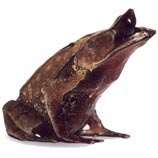 Begin
your lesson at the American Museum of Natural History's exhibit on Frogs:
A Chorus of Color.
Begin
your lesson at the American Museum of Natural History's exhibit on Frogs:
A Chorus of Color.
As you browse through the site, you can listen to the some of the frogs' songs using RealPlayer.
Start with the Introduction, where you'll learn about The Amazing Adaptable Frog, and find out What is a frog anyway?
What are the three types of modern amphibians? In what ways do they differ from each other in their physical features? Where are frogs not found in the world?
Next, check out the Featured Frog Species, like the Green Invaders. In what part of the country were American Bullfrogs native? Where did they become invasive and why?
Can you find these frogs on the next page? How exactly does such a well-matched camouflage appearance get that way?
What survival method does the Mean Green Eating Machine depend upon to survive dry times?
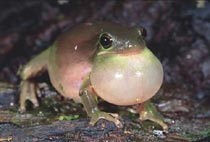 Now,
find out how Toothless
Predators catch food and how other frog species are good at
Parachuting/Defying Gravity.
Now,
find out how Toothless
Predators catch food and how other frog species are good at
Parachuting/Defying Gravity.
In what ways do specific physical characteristics help these different frogs to succeed in their local environments?
Also, find out why scientists tend to use certain species as Laboratory Frogs. What biological traits does the African Clawed Frog have that make it ideal?
Next, learn how some frogs have a Big Bark, Big Bite when it comes to defending themselves, and how some frogs on the hunt do best as Sit-and-Wait Predators.
What's the purpose of Frog Wrestling? How do Flashers evade predators? How exactly do Sticky Fingers work?
Why does the Wax On, Wax Off allow certain frogs to live in hot areas? Why are certain frog species endangered of becoming Frog Legs on someone's plate?
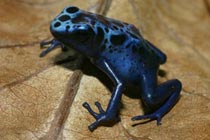 Now,
visit the Poison
Dart Frog Vivarium to find out what makes those species so Dazzling
and Dangerous.
Now,
visit the Poison
Dart Frog Vivarium to find out what makes those species so Dazzling
and Dangerous.
For example, as you'll soon discover, You are what you eat and that can make you Toxic To Touch.
So, in what ways do frogs generate toxic chemicals? What insights do cases of Convergent Evolution provide?
For what purpose have researchers been Frog Pharming? How do native peoples use Dart Poison?
In what ways do these frogs differ in their physical features?
How can some non-poisonous frogs live on the risky tactic that Looks Could Kill?
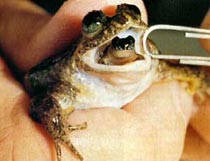 Now,
let's take a look at frog Reproduction
- from Egg, to Tadpole,
to Adult
and how they must protect Nests
and Nurseries from damage and predation.
Now,
let's take a look at frog Reproduction
- from Egg, to Tadpole,
to Adult
and how they must protect Nests
and Nurseries from damage and predation.
To take a more in-depth view of A Frog's Life, check out why scientists believe that one of the frog's earliest ancestors was A Fish Out of Water.
Here, you'll learn about what makes Frog Eyes unique, and how frogs - like other amphibians - depend on Thin Skin.
How do the eyes help frogs swallow food? What kinds of functions do bumps on the skin serve?
To what advantage do some frogs Make Like a Leaf, use Moveable Nurseries, exploit their becoming Accidental Tourists, or serve as Just a Gigolo?
How long can a Mating Embrace last?
Now that you know how they live, explore the close ties between Frogs and the Ecosystem.
What are some of the major causes of frog declines? What kinds of factors can cause physical mutations? What frog characteristics make it vulnerable to these factors?
Why have some native peoples Ritualized Frogs? In what ways are frog populations affected by The Pet Trade? How do frogs create Swamp Symphonies? What makes frog Ears unique?
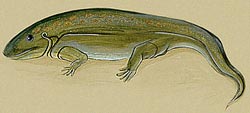 How
does a frog live Without
a Pond? For what ailments have a number of frog species - not
just the dart poison frogs - become Hopping
Drugstores for humans? Why are scientists interested in learning
more about Frog
Antifreeze?
How
does a frog live Without
a Pond? For what ailments have a number of frog species - not
just the dart poison frogs - become Hopping
Drugstores for humans? Why are scientists interested in learning
more about Frog
Antifreeze?
What are some ways we could keep Frogs in Our Throats without harming wild populations? What are frogs worth to us off the dinner plate?
If you have time, listen to more Frog Sounds and check out the Frog Facts.
Find That Frog
Okay, so now you know a lot about frogs, but what kinds of frogs live in your own backyard?
To find out, browse the National Wildlife Federation's gallery of Field Guides, and open up the one for Amphibians, focusing on Frogs and Toads.
From there, use the Filter for finding your Region by locating your state on the pull-down menu (look under United States first). This will pull up the frogs and toads that most likely live in your area.
(Note: If you create an account at the site, you can save species entries in a customized list for later reference.)
What do they look like? What kinds of habitats do the different species prefer? What do they eat? Listen to their voices - have you ever heard them around your neighborhood or other sites nearby?
Newspaper Activities
In current issues of The Salt Lake Tribune, look for any follow-up stories on the Amphibian Conservation Summit's commitment to boost amphibian conservation efforts. What species are scientists/conservationists targeting and in what areas are they found? What factors threaten those species the most? Are any of the species native to your region?
Also, look for any stories about frogs or other amphibians that live in your area. Which ones are native and which are not? How are the various species responding to the change in seasons or to smaller shifts in the weather? If you see an article about or advertisement by a local pet store, does the store carry any amphibian species? If so, do they say if the frogs or salamanders were captured from the wild or bred in captivity?
© Copyright 2005
Learners Online, Inc.
